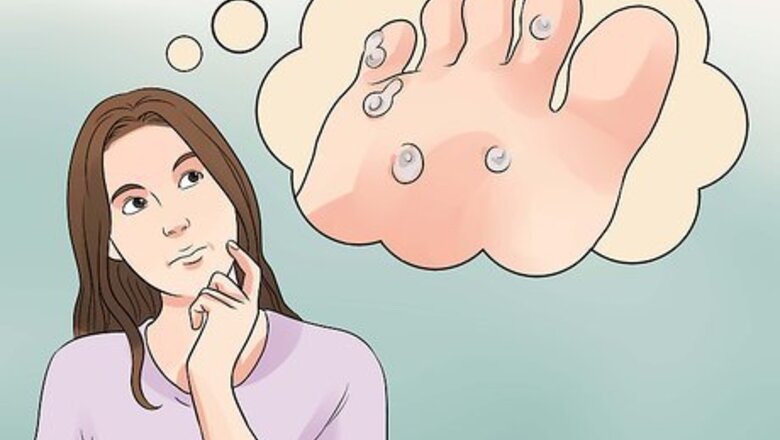
views
Assessing the Condition
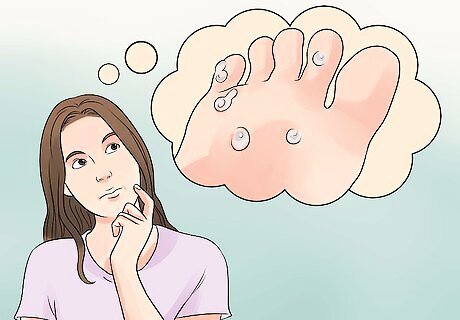
Consider how common warts are, and know that you are not alone with this problem. The plantar wart gets its name from being on the planter surface (the sole) of your foot. The human papillomavirus (HPV) is the virus that creates warts, and it invades your body in the superficial layer of your skin, thus causing a thickened growth that resembles a callous. It is more likely to occur in skin that has been broken open or is wet, but can occur in healthy dry skin as well. Warts may take up to six months to appear on the sole of the foot after exposure to the virus, so it can be difficult to trace back to the precipitating event.
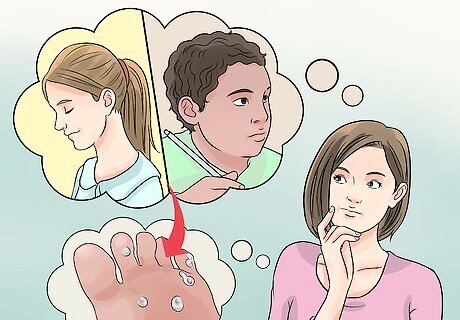
Be aware that warts are most common in children and young adults, which can help in diagnosing them. (However, it is possible for them to occur in people of any age.) They are also more common in people whose immune systems are compromised for other reasons, such as people with chronic skin conditions such as eczema, or people with organ transplants or HIV/AIDS.

Understand that for anyone with warts, it is easier to treat fewer, smaller warts. Some people try a "wait and see" approach to see if their warts will resolve on their own, but if you notice no improvement within a few weeks, or spreading or growth of the warts, your best bet is to seek treatment sooner rather than later.
Trying Home Remedies
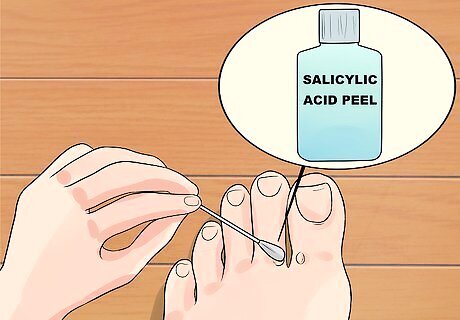
Use salicylic acid, at home or with the help of a healthcare provider if you would like additional guidance. Prior to treatment with salicylic acid, use a pumice stone to remove the outer layer of your wart(s), so that the dead skin cells (the callous part) are removed. You will know when you are done because the skin underneath the callous part is much more sensitive and it will hurt to continue scraping any further. Soak the affected foot (or feet, if you have warts on both sides) in warm water for 10–20 minutes prior to treatment. This softens the skin and enhances the effectiveness of treatment. Make sure your foot is completely dry after soaking to that the salicylic acid patch you will apply stays on as well as possible. Apply salicylic acid patch to the affected area of your foot. The best time to do this treatment is just before bedtime each night. Leave it on overnight, and remove it in the morning. Continue this treatment every night until the wart(s) is/are gone, and one to two weeks longer after they have disappeared to ensure that the HPV virus has been totally eradicated. Note that for people with "neuropathy" (medical conditions that relate to damage to their nerves), it is not advisable to use salicylic acid. This is because the decreased sensation for people with these conditions may result in the salicylic acid causing damage to their skin without them being able to notice it.
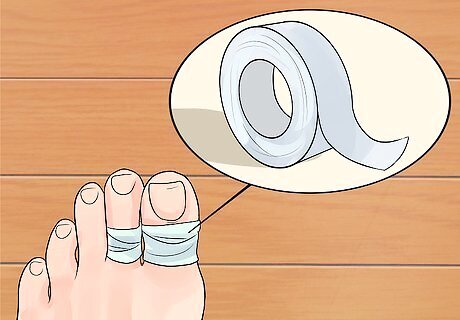
Try duct tape — another effective remedy that can be used at home. It is not fully understood why duct tape works as a treatment for plantar warts, but a number of scientific studies have shown that it has good success in a great number of people, so it is definitely worth a try. The silver duct tape available at most home improvement stores is better than the clear type, for the reason that it tends to stick better to the soles of the feet. Place it on the sole of your feet (a piece large enough to fully cover any and all warts), and leave it on for six days. If it falls off before then, replace it with a new piece of duct tape sooner rather than later as the goal is to keep the warts covered for a full six days. Then remove it for one day to let the area breathe. After removing it, soak your foot for 10–20 minutes in warm water to soften the skin, and use a nail file or pumice stone to scrape away dead skin on the surface. Note that people who do find success with the duct tape strategy tend to show improvement by the two week mark, and often complete resolution by the four week mark of using this treatment. If you do not find this is the case for you, it is best to move on and try other options. Be aware that if you have any of the following medical conditions — diabetes, poor circulation to your extremities (hands and feet, called "peripheral artery disease" by doctors), nerve problems (called "neuropathy"), or any chronic skin conditions — it is not advisable to use duct tape as a treatment, as it may irritate your skin as a result of having these conditions.
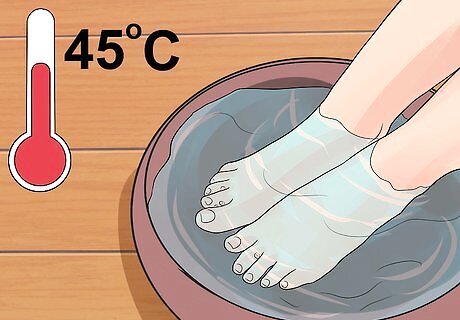
Try exposing the wart(s) to high temperatures (this is called "hyperthermia"). This entails exposing the affected area of your foot/feet to water of approximately 113 °F (45 °C), for 30–45 minutes two to three times per week.

Use garlic cloves. When applied to the site of the wart(s) and rubbed over them every night (followed by covering the area with a bandage or duct tape), this has been shown to be successful for some people. Garlic has antiviral properties, which likely explains the utility of this form of treatment. If you do not notice any improvement after two to three weeks, move on to trying another form of treatment.

Try tea tree oil. This has also been shown to have antimicrobial properties and, when applied nightly to the area of your wart(s) and covered afterwards with a bandage, this is another easy "home option" for treatment. Again, if you do not notice any improvement after two to three weeks, move on to trying another form of treatment.
Trying Prescription/Procedural Treatments
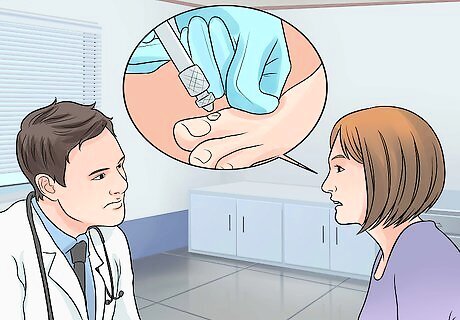
Ask your doctor to try cryotherapy (also called liquid nitrogen). This is where a very cold liquid is applied to the skin that destroys plantar warts by freezing them. Most often you will have to return to see your family doctor several times to receive multiple liquid nitrogen treatments, before the wart (or warts) completely goes away. Your doctor can provide a schedule of how frequently she would like to see you. After the wart disappears, it is most often recommended to use salicylic acid as a follow-up to treatment for one to two weeks to ensure that the wart does not return. Due to some pain that accompanies treatment with liquid nitrogen, it is not recommended for young children. However, older children and adults tend to have no problem with it. Know that there is the possibility with this treatment (for people with darker skin) to have some depigmentation (lightening of the skin) in the area of treatment. If this is a cosmetic concern for you, speak to your doctor who may recommend alternative modes of treatment for your wart(s). If you notice any depigmentation that bothers you after the first liquid nitrogen treatment, you may choose not to continue. The damage from a single treatment will likely be very minimal (if at all), but it could be permanent so it is best to opt out if this bothers you.
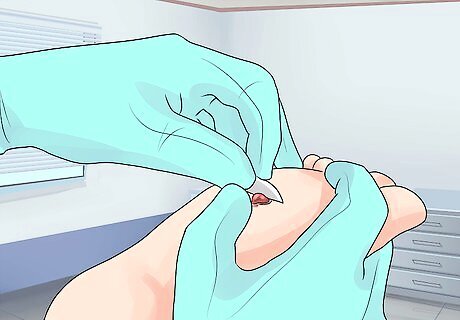
Try having your wart removed via shave excision. This is a procedure done by your doctor, if liquid nitrogen alone is unsuccessful. If your doctor deems that this procedure is what you need, he or she will first inject some local anesthetic (freezing agent) into your skin in the area around the warts. This freezing ensures that the procedure can be done without causing you undue pain. After the freezing is complete, the doctor will use a small scalpel to excise, or remove, the wart(s) from your skin. Your doctor will likely recommend follow-up treatment of some sort to give the maximum chance that the wart(s) will not return.
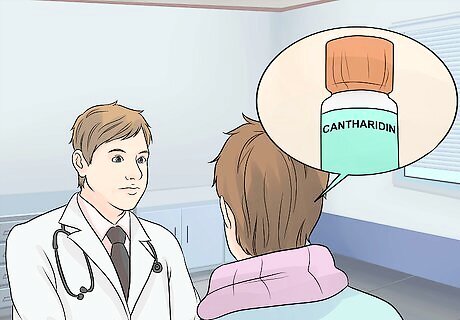
Ask your doctor about other medical treatments. These include Cantharidin, 5-Fluorouracil, Imiquimod, and other forms of "immunotherapy." These tend to be used later down the line, but are certainly options you and your doctor can talk more about together. Your doctor may also consider an injection into the wart itself. This is a procedure done by your doctor for cases that are unsuccessful with other modes of treatment. Finally, your doctor may try laser treatments (or phototherapy). This is another option available to patients whose warts persist despite trying other simpler treatments.




















Comments
0 comment